Turkmenistan
 From Rationalwiki
From Rationalwiki _-_TKM_-_UNOCHA.svg.png)
“”Turkmenistan is a country often overlooked on the world stage. When attention is paid the focus tends to be either on the size of its bountiful gas reserves or on the eccentricities of its leadership. [But Turkmenistan is] a country in the middle of a sustained economic crisis that has seen hyper-inflation in the lives of ordinary people and widespread food shortages. This economic crisis has in turn led to the regime’s repression becoming ever tighter and its personality cult becoming ever more grandiose.
|
| —Adam Hug, The Foreign Policy Centre.[1] |
The Republic of Turkmenistan is one of the former Soviet constituent republics. Out of all of the former Soviet republics, it is the most corrupt and least democratic, ranking right below Tajikistan. It's perhaps most notable for the famously crazy personality cult built around its first dictator, President for Life Saparmurat Niyazov, who ruled until he died in 2006. Niyazov renamed whole months after himself and his family members, built a golden statue of himself that rotates to face the sun, and required students to learn and take spiritual guidance from his evidently stultifying stream-of-consciousness book Rukhnama. One reviewer wrote, "On a lark, I decided to read through some of this book. It was absolutely painful. It is filled with such flaccid ghost-written text that it makes Leviticus seem like an action thriller." The reviewer goes on to say he would need a gun held to his head to motivate him to read any more of it; ironically, that was a common practice in Turkmenistan.[2][3] After Niyazov's death, he was succeeded by Gurbanguly Berdimuhamedow, his personal dentist.[4] Berdimuhamedow continued his mentor's tradition of turning Turkmenistan into an international joke. In 2019, for instance, he attracted ridicule for filming a video where he taught his government ministers how to exercise.[5] Amazing. The Turkmen clown show is run from Ashgabat, its capital and largest city. The vast majority of its oppressed population are Turkmen Turks who follow Islam.
Turkmenistan's current state is tragically short of its lofty beginnings. The region grew rich on the Silk Road trade with Imperial China, and its main city Merv was once the largest in the world.[6] After the introduction of Islam to the region, Merv became one of the central cities of the Muslim world as well. Everything changed when the Mongols came through the area, destroying Merv and ending Turkmen urban civilization. The Turkmen Turks became a nomadic people feared throughout the region as raiders and slave traders.[7] The Russian Empire conquered the area in a process that ended in 1881. During World War I, Turkmenistan joined the anti-conscription revolts in the empire before being conquered again by the Bolsheviks.
Under the Soviet Union, Turkmenistan had its agriculture modernized, and its nomadic peoples forcibly settled into urbanism. However, the Soviets did little to help the republic beyond that, and it remained a simple production region untouched by the outside world's broader cultural and economic trends. After the union's dissolution in 1991, then-communist leader Saparmurat Niyazov maintained his power by creating a cult of personality and focusing on Turkmen nationalism. Niyazov's regime proved unrelentingly authoritarian as he frequently conducted violent purges of non-conformists. Apart from selling oil and natural gas, Niyazov kept Turkmenistan isolated from the rest of the world and largely undeveloped. This ensured that the country would be his personal playground. His successor Berdi did little different. Berdi's son took office in 2022.
History[edit]
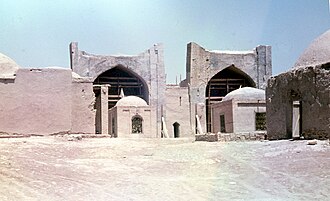
Early history[edit]
Turkmenistan originated from the old Turkic tribes of Central Asia, and the ancestors of modern Turkmens descended from those Turks who migrated into the region through extensive military campaigns against the Persians who originally lived there, completing the consolidation of their rule over the region in the 8th century.[8] The Turkmenistan region ended up being one of the best they could have settled in, as it had areas rich in water and lay on one of the main paths of the Silk Road.
When they moved in, the Turkmens inherited the great city of Merv, and Merv proved to be one of the ancient world's greatest cities. Merv's population reached a peak above 700,000 and possibly over a million.[9] It quickly became the administrative, commercial, and religious nexus of Turkic Central Asia. Merv was home to much of the intellectual and artistic traditions of the Islamic world during its golden age. It was also religiously significant in the Zoroastrian religion, being one of the cities to hold the "horn of plenty".[10]
The Turkmens were introduced to Islam by the Seljuk Empire, which was dominated by Turks who also converted. The term "Turkmen" emerged during this time to distinguish those Turkic peoples who were the first in the region to adopt the religion.[8] Turkmen tribesmen were integral to the Seljuk military for centuries until they eventually rose up to overthrow the empire.
Decline and Russian conquest[edit]
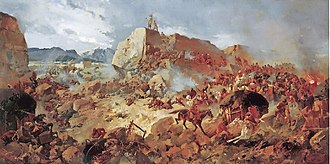
According to contemporary sources, the city of Merv fell to the Mongol invasions that shook Central Asia from 1220 to 1223, and the city's destruction killed as many as a million people.[11] The Mongols also destroyed the region's extensive irrigation system, ruining its agriculture and forcing people out of urban cities to survive as nomads in the desert.
As nomads, the Turkmen served various empires ruled by Uzbeks and other Central Asian cultural groups. Despite occasionally serving various empires, the Turkmen tribes remained largely autonomous and resisted any attempts to change that. They were hard warriors and were known as raiders who attacked urban and agricultural settlements to capture slaves to fuel the Central Asian slave trade.[12] Throughout the 18th century, the Turkmen started dragging themselves back to civilization after centuries of poverty and nomadism. The poet Magtymguly codified an actual literary language for the Turkmen, and Turkmen merchants began trading with Russian frontiersmen.[13]
Russian encroachment into Turkmenistan began in the later 19th century. Of all the Central Asian peoples, the Turkmen put up the stiffest resistance against Russian expansion, and the Russians retaliated by destroying Turkish settlements.[14] The Russian conquest of the region ended with the Battle of Geok Tepe in 1881, where the Russians used artillery to smash down the fort and defeat the last Turkmen army.[15]
Russian rule[edit]
._У_городских_ворот.jpg)
Following annexation to Russia, the area was administered as the Trans-Caspian District by corrupt and malfeasant military officers and officials appointed by the Guberniya (Governorate General) of Turkestan.[13] Turkmenistan served as a military outpost against Afghanistan. The Russians assumed their imperialism would take them further south and eventually conflict with the British Empire's holdings in India and Pakistan.
After it became clear that the Russians and British would simply use Afghanistan as a buffer state to maintain peace,[16] the region became a province known as Russian Turkestan, which was governed as a normal colonial holding. Still, Turkmenistan was totally neglected by the Russians, allowing them to keep their nomadic lifestyle and cultural traditions.[13] That came with the consequence that Turkmenistan remained unaffected by modernization trends that affected the rest of the region. The region was a backwater, one of the most isolated in the world.
During World War I, the Russian Empire started forcibly drafting Central Asians into its armies to compensate for manpower losses. The Central Asians didn't appreciate having to die for an empire that had never done anything for them, and they rose up in the so-called "Basmachi movement".[17] After the Russian Empire collapsed after the October Revolution, the Basmachi movement quickly adopted the grander goal of full independence and restoring Muslim rule. This included resistance against the oncoming Bolsheviks.
Soviet rule[edit]

Soviet policy towards the Turkmen and the other Basmachi participants was initially harsh, as they implemented anti-religious policies like banning the Quran in schools and nationalizing clerical-held land.[18] This was terrifyingly radical for the Turkmen, who had been the most backward and isolated part of the Russian Empire. The Turkmen and the Basmachi armies fought a resistance war against the Red Army from 1924 to 1926. Despite being outmatched, they could deny the Reds a clean military victory.[18] Instead, the war ended when the Reds promised to moderate their anti-religious policies.
The Reds still remembered, though, and they waited only a few years before they started attempting to modify Turkmen traditions again. This effort truly kicked off under the ruthless Joseph Stalin, who sent troops to forcibly settle Turkmen nomads and collectivize agriculture.[19] Many fled to Iran and Afghanistan rather than live inside the Soviet Union.
The primary Soviet purpose for Turkmenistan was the same as the Soviet aim for much of Central Asia: cotton production. The Soviets built extensive irrigation systems to make the deserts livable, and they then put the former nomads to work on plantations.[20] Once production was stable, though, the Soviets promptly lost interest in the region.
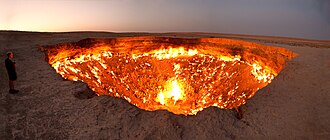
Political and economic leadership was held almost exclusively by Russian migrants who had been sent by the Moscow government to manage Turkmen affairs.[20] There was also a small, educated elite class of Turkmen considered loyal to the Communist Party. The Communist Party proved to be much more autocratic here than elsewhere in the Soviet Union, gradually closing nearly all Turkmenistan mosques and ignoring the Mikhail Gorbachev reforms.[20]
As a result of its isolation, the republic was unprepared for the rising tide of nationalism sweeping the Soviet Union and quickly tearing it apart. Turkmen popular opinion also went with the new trends. Still, the government and its Saparmyrat Niyazov preferred to stay with Russia as the Turkmen economy was not ready to stand independently.[21] However, the 1991 coup against Gorbachev and the dissolution of the Soviet Union forced Niyazov's hand, and he offered the people an independence referendum. When the people voted 94% to break free from the Soviet Union, Niyazov complied with the result and declared independence in 1991.[21]
Niyazov regime[edit]

After independence, Niyazov continued as Turkmenistan's head of state, replacing communism with a unique brand of independent nationalism reinforced by a pervasive cult of personality. Turkmenistan's standard of living was already the lowest among the Soviet republics. That situation deteriorated as Niyazov could not handle the economic shock of transitioning into a post-Soviet state.[22] In the hopes of offsetting the economic crash, Turkmenistan came to rely more and more on its oil and natural gas reserves. The profits went into state-owned companies dominated by greedy and corrupt oligarchs.

Niyazov was a total madman and fully controlled Turkmenistan's finances and government. He first primed the idea of himself as eternal god-president by sending it through the state media and then, in 1999, had himself declared "President for Life".[23] With all that power, Niyazov promptly started doing all that stereotypical dictator shit that normal people only occasionally fantasize about. Building statues? Sure! Motherfucker had the state build a giant tripod on which there was a 39ft (12m) golden statue of himself that would always rotate to face the sun.[24] He then renamed all of the months and most of the days of the week after himself, his family members, and the people he admired.[25] If that wasn't enough, he then bulldozed hundreds of homes in the capital city to build a Niyazov-themed amusement park called the "Land of Fairy Tales".[26] Man built his own Disneyland. It promptly fell into neglect after Niyazov lost interest in it.[27]

Also, like any good despot, Niyazov wrote a really shitty book and then ordered people to read it. His magnum opus, the Ruhnama, was extra shitty, with stream-of-consciousness-writing, random reminders to wear clean clothes, and the bizarre claim that the Turkmen nation was descended from Noah.[28] He had his people treat it like the damn Bible, carving its title on mountains and having TV programs sign off with readings from the book. Oh, and he naturally had a giant statue built of the book.[29]
Still, Niyazov's amusing dictator antics shouldn't distract you from the sheer suffering he inflicted on his own country. While he frittered away his oil money on lavish monuments to himself, the Turkmen people had to endure famines, arbitrary arrests, torture, and the random bulldozing of entire neighborhoods to make way for vanity projects.[30] As one of his last acts, Niyazov made things even worse by ending state maternity and sick leave payments and canceling pensions paid to 100,000 senior citizens.[31]
Berdi family regime[edit]

“”Turkmen President Berdimuhammedov is vain, fastidious, vindictive, a micro-manager.... Berdimuhamedov does not like people who are smarter than he is. Since he's not a very bright guy, our source offered, he is suspicious of a lot of people.
|
| —Leaked United States assessment of Turkmenistan's former dictator.[32] |
After Niyazov died in 2006, his dentist (because that was how little he trusted his son with the office), Gurbanguly "Berdi" Berdimukhammedov, rose from total obscurity to take his place.[33] The elder Berdi continued most of his predecessor's old traditions, including building a giant golden statue of himself on a horse[34] and then topping it by building a giant golden statue of his favorite dog.[35] He also went to great lengths to build his own personality cult, and on one occasion, he fell down some steps in front of a crowd and then had his security guards hassle everyone present to ensure there wasn't any footage.[36] Despite having a face that could scare a baby, the elder Berdi has crafted the image of a hip action hero, riding horses everywhere, writing and performing rap songs, driving sports cars, and lifting gold weights on TV while his cabinet members clap for him.[37]
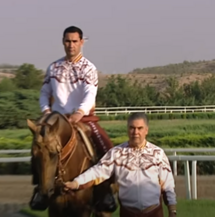
He's also continued the political repression and looting of Turkmenistan. His ostentatious displays seem calculated to distract the country from its poverty and the poor treatment they receive at his regime's hands. As amusing as his antics are, they shouldn't distract from the fact that the elder Berdi and Niyazov have run their countries like North Korea, allowing famines to ravage the countryside while they party in the capital. As of 2019, Turkmenistan is facing the worst economic crisis in 30 years, and the state is trying to make up for it with forced labor and large-scale arrests of dissenters.[38]
He is also highly obsessed with horses, so many have half-jokingly suggested that he's secretly a zoophile.[39]
Although all forms of media are heavily censored, what information there is shows that most Turkmen are fully aware of how broken and corrupt their government is. The issue is that most of them prefer to flee the country rather than attempt to change things, as few believe that any opposition attempts would succeed.[40]
In 2022 after 15 years of running the country, Gurbanguly handed the keys to the country to his son Serdar.[41] Little is currently known about Serdar and how he plans to run the country. However, former colleagues have described him as paranoid about his security and as looking down on subordinates, which could lead to harsher authoritarian crackdowns in the future.[42] In addition, Serdar has been described as much more quiet and joyless than his father and more confident and nastier in person. In fact, among exiles, there are rumors that Serdar is afraid of horses and can't ride them, unlike his father.[43]
About the horses[edit]
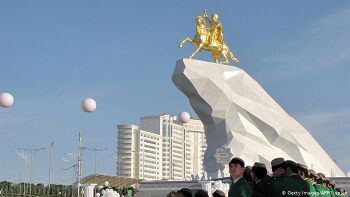
“”Our country is moving forward with the speed of an Akhal-Teke stallion and I call on you all to move forward and only forward
|
| —Gurbanguly Berdimukhamedov[44] |
You know how we said he's highly obsessed with horses? Yeah, it's enough to warrant its own section.
The elder Berdi is specifically obsessed with a breed called the Akhal-Teke, likely due to it being a beloved national symbol in his country. But that alone does not excuse the sheer degree to which his obsession goes.
- He gives Akhal-Tekes as gifts to other world leaders.
- He has written multiple books on horses.
- He awarded himself the title "The People's horse breeder."[44]
- He made it illegal to change a horse's name during its lifetime in his country.
- He has issued state-sponsored horse beauty contests.
- He owns over 600 Akhal-Tekes, nearly a tenth of the world's total.
- When someone recently gave him an Akhal-Teke foal named Rowatch as a gift, he wrote a poem about it that reads like one someone from the 19th century would send to their crush!
- His office features:
- a throne with adornments in the shape of horses.
- horse-accented cabinetry
- a white horse statue.
- a gold horseshoe statue
- a custom desk inlaid with gold horses.[39]
We swear we're not making any of this up.
Human rights[edit]
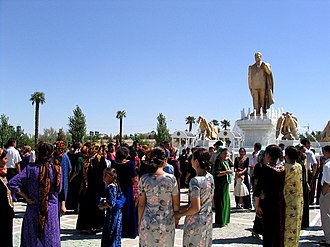
Freedom of speech and expression[edit]
“”Turkmenistan is one of the world’s most closed countries. The government controls all media and the few Internet users are able to access only a highly-censored version of the Internet, often in Internet cafés in which they must show ID before being able to go online. There is only one Internet access provider.
|
| —Reporters Without Borders.[45] |
Turkmenistan is remarkable for its absence of media freedom, where Reporters Without Borders refers to it as a "media black hole". The internet is barely accessible, and what exists is heavily censored by the government. The very few independent journalists brave enough to practice in Turkmenistan are often arbitrarily arrested and tortured whenever they somehow piss off the government.[45]
The state also controls all forms of paper and electronic media, and they forbid almost all access to the country for foreign news outlets.[46] This has gone to absurd lengths. In 2015, the government carried out what Human Rights Watch termed the "War on Satellite Dishes", sending agents to tear down privately-owned satellite dishes to further limit the information available to its citizens.[47]
Legally speaking, any opposition to the government is considered treason, and citizens may be arrested and tortured just for speaking their minds.[48] The government also controls universities and book publishing.
Among the offenses punishable by arrest or disappearance is simply mentioning the existence of COVID-19, as the government stubbornly insists that the pandemic doesn't exist inside their borders.[49]
Totalitarianism[edit]
_05.jpg)
The government may arbitrarily and without warning make drastic changes to its citizens' personal lives. The government bulldozes residential areas in its capital to make way for vanity projects, and the victims are left homeless and without compensation.[50] If you needed any more evidence that the government just doesn't give a single flying fuck, satellite evidence shows that Turkmenistan will occasionally bulldoze neighborhoods and then just leave them as empty fields.[51]
Oh, and if that wasn't enough, one day out of the blue, the government sent workers to remove air conditioning units from apartment buildings in the capital.[52] Government airplanes have also recently started spraying residential areas and agricultural fields with potentially toxic disinfectants to fight COVID-19, a virus they say officially doesn't exist in the country.[53] That's right, Turkmenistan made fucking chemtrails real.
The government is also heavily rationing food and basic supplies in the face of a worsening economic crisis. However, the government is still spending heavily on stupid bullshit,[54] such as spending $680 million on celebrating "National Horse Day".[55]
Forced labor[edit]

Turkmenistan uses forced labor, a nice way to say "slavery", to produce its cash crops of cotton, wheat, and rice. All land belongs to the government, and the state forces people who aren't farmers to spend months out of the year toiling in the fields for almost no pay.[56] This leaves much of the service sector, including healthcare and education, idle. Instead of trying to change anything about this system, Turkmenistan harasses anyone who speaks out against it or reports these abuses to foreign media.[57] People being forced to work are threatened with punishments including public humiliation, wage deductions, and termination of employment at their regular jobs.[58] In 2018, the US started enforcing a law that bans slave-made goods, meaning that Turkmen-produced cotton is not allowed inside the US.[59]
The government also runs a "summer camp" where children are forced to go out into fields and do hard agricultural labor, using monstrously antiquated and intensive methods, while being denied food and water.[60] The parents had to pay the government for that privilege.
And if that wasn't enough to get the people tired, the government also holds mandatory mass exercise sessions during World Health Day.[61]
Torture and mistreatment[edit]
Torture and mistreatment are central features of Turkmenistan's prisons, and the government refuses to disclose how many political prisoners they have or who they are.[46] This is a key part of the state's atmosphere of terror, as it's impossible to know if someone is killed after disappearing or is simply hauled off to a prison to be gruesomely tortured. Methods of torture include severe beatings, kidney punches, and leaving prisoners in the sun or the harsh cold for hours and hours.[48] This is even done in pretrial detentions, often resulting in death.
Gallery[edit]
.jpg)
Ashgabat, the dictator's playground.
.jpg)
Turkmen sturgeon kebabs.
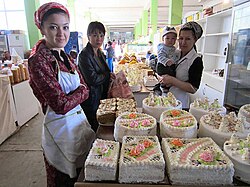
Cake shop in a Daşoguz bazaar.
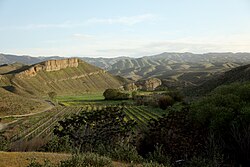
Agriculture in Turkmenistan.
See also[edit]
- Kazakhstan
- Eritrea
- North Korea
References[edit]
- ↑ Spotlight on Turkmenistan: Executive Summary. The Foreign Policy Centre.
- ↑ https://www.amazon.com/Rukhnama-Reflections-Spiritual-Values-Turkmen/product-reviews/B000K9GX3O?reviewerType=all_reviews
- ↑ The personality cult of Turkmenbashi. The Guardian.
- ↑ Niyazov's Cult of Personality Grips Turkmenistan. NPR.
- ↑ Turkmen president ridiculed for exercise video. BBC News.
- ↑ Lost cities #5: how the magnificent city of Merv was razed – and never recovered. The Guardian.
- ↑ Paul R. Spickard (2005). Race and Nation: Ethnic Systems in the Modern World. Routledge. p. 260. ISBN 978-0-415-95003-9.
- ↑ 8.0 8.1 Turkmenistan: Origins and Early History. Country Studies.
- ↑ Ancient Merv. Atlas Obscura.
- ↑ Turkmenistan on the Silk Road. Advantour.
- ↑ The Desolation of Merv. The Diplomat.
- ↑ Scott Cameron Levi (January 2002). The Indian Diaspora in Central Asia and Its Trade: 1550–1900. BRILL. p. 68. ISBN 978-90-04-12320-5.
- ↑ 13.0 13.1 13.2 Russia and Turkmenistan. Global Security.
- ↑ Turkmenistan: Incorporation into Russia. Country Studies.
- ↑ See the Wikipedia article on Battle of Geok Tepe.
- ↑ See the Wikipedia article on The Great Game.
- ↑ See the Wikipedia article on Basmachi movement.
- ↑ 18.0 18.1 The Basmachi or Freemen's Revolt in Turkestan 1918-24. Soviet Studies. Vol. 33, No. 3 (Jul., 1981), pp. 352-369 (18 pages)
- ↑ Soviet Turkmenistan. Country Studies.
- ↑ 20.0 20.1 20.2 TURKMENISTAN UNDER RUSSIA AND THE SOVIET UNION. Facts and Details.
- ↑ 21.0 21.1 Turkmenistan: Sovereignty and Independence. Country Studies.
- ↑ TURKMENISTAN BECOMES INDEPENDENT. Facts and Details.
- ↑ Turkmenistan: Niyazov Named President For Life. Radio Free Europe.
- ↑ Arch of Neutrality. Atlas Obscura.
- ↑ Turkmenistan to drop late dictator's month names. The Guardian.
- ↑ Turkmenbashi's Land of Fairy Tales. Atlas Obscura.
- ↑ Turkmenbashi's Land of Fairy Tales. Theme Park Guy.
- ↑ A dictator's guide to the universe. The Guardian.
- ↑ Giant Ruhnama. Atlas Obscura.
- ↑ Turkmenistan Seen to Be Suffering. The Oklahoman.
- ↑ Turkmenistan despot axes pensions. The Guardian.
- ↑ US embassy cables: Turkmenistan president 'not a very bright guy'. The Guardian.
- ↑ Turkmenistan: Who Is Gurbanguly Berdymukhammedov? Radio Free Europe.
- ↑ Turkmenistan Unveils a 69-Foot Distraction. The Diplomat.
- ↑ Turkmenistan leader unveils giant gold statue of local dog. The Guardian.
- ↑ A horse, a horse … Turkmenistan president honours himself with statue. The Guardian.
- ↑ Meet the dictator who rules secretive Turkmenistan, who portrays himself as an action hero and shows off by lifting gold bars in parliament. Business Insider.
- ↑ Hyperinflation and hunger: Turkmenistan on ‘edge of catastrophe’. Al Jazeera.
- ↑ 39.0 39.1 Gurbanguly Berdimuhamedov: Last Week Tonight with John Oliver (HBO) YouTube
- ↑ 'Edge of catastrophe': report warns firms and governments off Turkmenistan. The Guardian.
- ↑ https://www.rferl.org/a/turkmenistan-serdar-berdymukhammedov-presidency/31753690.html
- ↑ https://www.rferl.org/a/turkmenistan-serdar-berdymukhammedov-presidency/31726284.html
- ↑ https://eurasianet.org/turkmenistan-who-is-mister-serdar-berdymukhamedov
- ↑ 44.0 44.1 Shaun Walker 25 May 2015 A horse, a horse … Turkmenistan president honours himself with statue The Guardian
- ↑ 45.0 45.1 Turkmenistan: Ever-expanding news “black hole”. Reporters Without Borders.
- ↑ 46.0 46.1 World Report 2020: Turkmenistan. Human Rights Watch.
- ↑ Turkmenistan: War on Satellite Dishes. Human Rights Watch.
- ↑ 48.0 48.1 2019 Country Reports on Human Rights Practices: Turkmenistan. US State Department.
- ↑ In Turkmenistan, Whatever You Do, Don't Mention The Coronavirus. Radio Free Europe.
- ↑ Turkmenistan: Homeowners Evicted, Denied Compensation. Human Rights Watch.
- ↑ Satellites confirm Turkmenistan is not rebuilding homes it destroyed. Eurasia Net.
- ↑ Turkmen Defy Officials In Rare Public Protest. Radio Free Europe.
- ↑ Citizens Frightened As Turkmenistan Sprays Disinfectants From Planes To Fight Coronavirus. Radio Free Europe.
- ↑ Turkmenistan Further Tightens Food Rationing Amid Price Hikes, Shortages. Radio Free Europe.
- ↑ Turkmenistan Holds National Horse Day, Authoritarian Leader Reveals $680 Million Spent On His Passion. Radio Free Europe.
- ↑ Turkmenistan's Forced Labor Problem. Cotton Campaign.
- ↑ Turkmenistan Remains at Lowest Possible Ranking in US TIP Report. International Labor Rights Forum.
- ↑ Turkmen cotton and the risk of forced labour in global supply chains. Anti Savery.
- ↑ U.S. bans imports of slave-picked cotton from Turkmenistan. Reuters.
- ↑ Summer Camp From Hell: Turkmen Children Sent To Dig Potatoes. Radio Free Europe.
- ↑ Amid Pandemic, Turkmenistan Holds Mass Exercise Events To Mark World Health Day. Radio Free Europe.
Categories: [Asian countries] [Authoritarian regimes] [Crimes against humanity] [Government incompetence] [Slavery] [Totalitarianism]
↧ Download as ZWI file | Last modified: 11/07/2025 00:05:21 | 60 views
☰ Source: https://rationalwiki.org/wiki/Turkmenistan | License: CC BY-SA 3.0

 KSF
KSF